
The Celestron Trailseeker 8 x 32 mid-size binocular.
Are you looking for a good quality mid-size binocular but don’t have £1000+ to spend on a Swarovski or a Leica or some such? Perhaps you’re looking for a nice Christmas gift for a loved one or a friend? Well, the Celestron Trailseeker 8 x 32 binocular could well be all the instrument you need!
If you’ve been following my binocular blogs, you’ll know that I have had to follow a very steep learning curve in order to bring my readers genuinely good bargains. And while it is generally true that you get what you pay for, there are always products that surprise in very pleasant ways, and this little binocular is one such instrument!
Celestron is not a name you’d normally associate with a high-quality roof prism binocular, but their optical engineers have successfully designed a great product in their Trailseeker range. The Trailseekers all feature full broadband multicoatings on all optical surfaces. The BAK-4 Schmidt-Pechan prisms are both phase and dielectricly coated to increase light transmission to the order of 85+ per cent, making it as efficient as ultra-premium models costing many times more.
The binocular measures 4.8 inches wide and 4.8 inches deep, standing just 1.9″ high; so very compact and easy to store in a backpack or small carry case. The binocular can be easily mounted to a tripod or monocular for additional stability.
My flashlight tests carried out indoors, as well as those conducted out of doors on bright street lighting and strongly backlit scenes showed that this model has excellent stray light and glare control. Indeed, its baffling of stray light is up there with the very best binoculars I have had the pleasure of testing. I was very impressed by how resilient this binocular is to the intrusion of stray light! Internal reflections were well nigh eliminated. What that means in practice is that you get very high contrast images, rich in detail that would impress most anyone who tries them out! I did however detect a weak diffraction spike which I could also make out on bright sodium light sources at night.
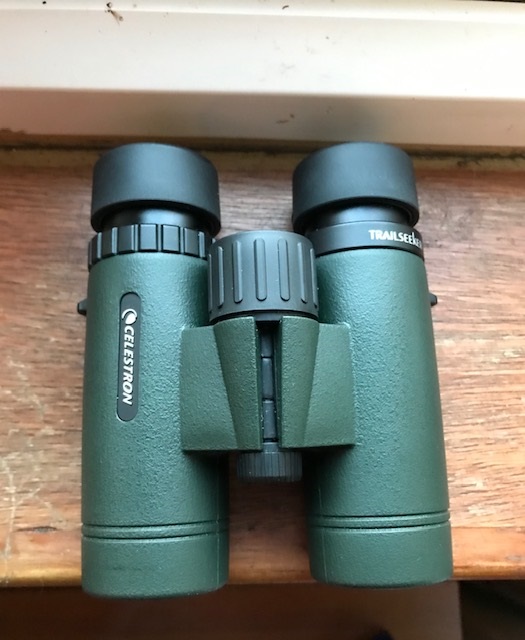
The Trailseeker has a very robust magnesium alloy chassis; a feature often only found on premium models.
The binocular has a very strong and robust magnesium alloy chassis that is often only offered in the most expensive brands. It is also remarkably lightweight, tipping the scales at just 454g(16 oz). The strong, lightweight alloy frame also means that it will withstand knocks and bumps better than other models having cheaper plastic or polycarbonate housings. The optics are 0-ringed sealed and purged with dry nitrogen gas to prevent internal fogging during cold-weather applications and corrosion of any metal parts used inside the instrument. The chassis is finished in a thick, rubberised green armouring that has excellent grip and which protects the main body from the elements. The underside of the binocular has neat thumb indents that make gripping the instrument very intuitive.
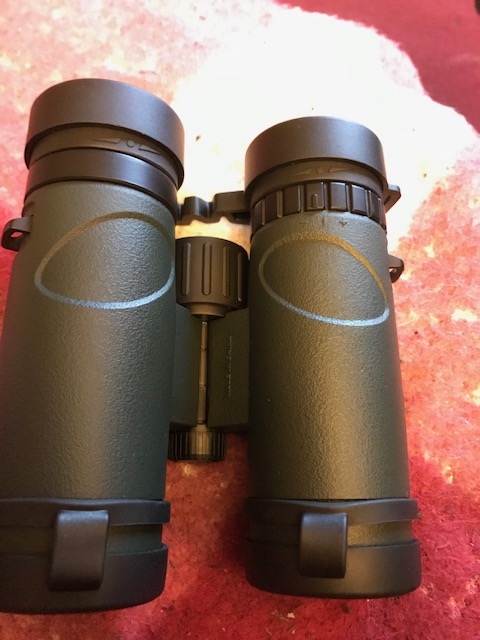
The underside of the Trailseeker has neat thumb indents that make handling the instrument very easy and intuitive.
The eyecups are of very high quality. They are made from solid metal with a soft, rubberised finish that makes them very comfortable to observe through. The eyecups twist up with two stops and hold their positions very well indeed, with absolutely no play. The eye relief is 15.6mm which is adequate for most eyeglass wearers. Close focus is about 6 feet and the field of view is a very generous 7.8 angular degrees(136m@1000m).The dioptre setting is located under the right ocular lens and has just the right amount of friction to keep it rigidly in place from day to day, and from week to week.
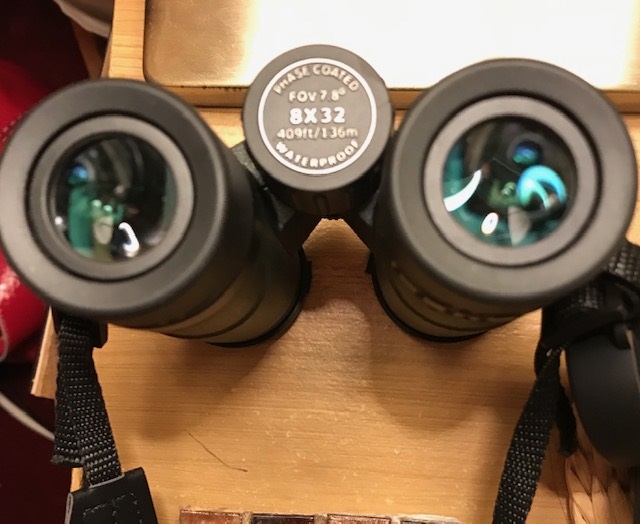
The focuser and ocular lenses of the 8 x 32 Celestron Trailseeker.
Optically, the 8 x 32 Trailseeker packs a very powerful whallop. The instrument arrived well collimated out of the box, as evidenced by the perfectly correlated left and right eye images of a chimney located about 150 yards in the distance. The images are razor sharp with a large central sweet spot, softening as you move toward the edge, just like any other binocular. Chromatic aberration is a total non issue(I think this issue in many good quality binos available today has more heat than light). I see a lot of amateurs making bold claims about how ED glass elements make the image ‘brighter’ but in reality, the brightness of the image in the best quality binoculars has little to do with ED glass and much more to do with the quality of the coatings(particularly those of the dielectric variety) employed on the roof prism. For example, I was quite taken aback when I tested this unit out in low light conditions during dusk, when they completely outperformed a very high quality 8 x 25 pocket binocular lavished with premium ED Schott glass and dielectric coated roof prisms. There was no magic though; the very efficient light gathering capabilities of the Trailseeker’s larger 32mm objectives stole the show; it was much brighter, no ifs or buts about it!
A Curious Aside: I wanted to get to the bottom of this somewhat ‘fishy’ claim regarding ED glass, you know; that it gives brighter images and all that, so I decided to investigate some products on line. I mean, I can see why a better focused image in an ED instrument would confer a very slight advantage over a standard achromatic unit with the same coatings, but certainly not to the extent some folk have claimed in the past. Well, I didn’t have to search long before I stumbled on a company, Hawke, who make a few models of 8 x 32s, and out of sheer dumb luck(not really), I was able to compare the specifications of their Endurance ED 8x 32 and their Fronier HDX 8 x 32. As you can see from the specs, the Endurance ED does indeed have ED glass, while the Frontier HDX does not. However, it is the latter that sells for a higher retail price(£259 as opposed to £199)! The one significant difference between these models is that the Endurance ED does not have dielectric coatings on the prisms while the HDX model does. And as this chap confirms, the HDX delivers the brighter image!
So there you have it!
I will further investigate these claims in a later blog, God willing.
No’ bad ken?
NB: The author has no affiliation with any of the binoculars discussed in any of his blogs.
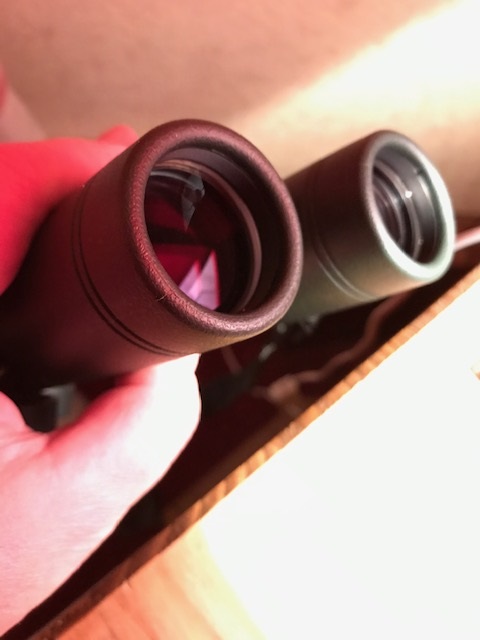
A good design feature: the deeply recessed (9mm) objectives are well protected from rain, dust and peripheral glare.
Although not my favourite size of binocular, the 8 x 32 format is great for birding and other nature studies. Its greater light grasp and generous field of view will enable the user to work under fading light more efficiently and for longer than any pocket glass. The central focuser is well made but was a little on the stiff side when I first acquired it. But with regular use, it has loosened up nicely to allow good, fast focusing on mobile targets like birds in flight, or scurrying squirrels racing up and down a tree trunk. Going from one end of the focus travel to the other involves turning the focus wheel through one and a half full revolutions.
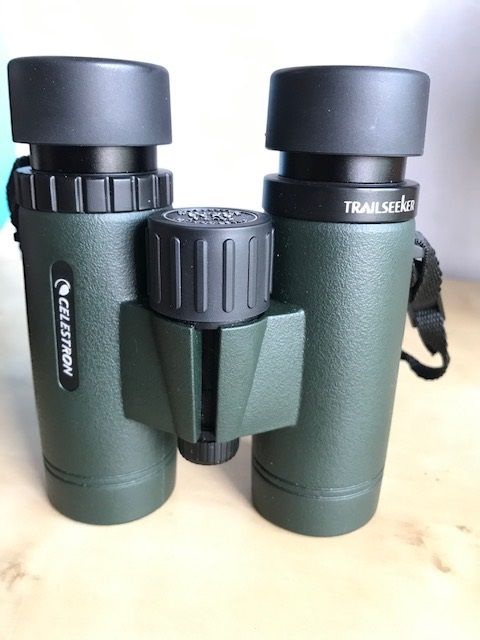
The Celestron Trailseeker 8 x 32 has very high quality twist up eyecups which make viewing through them very comfortable and immersive.
The little Celestron Trailseeker 8 x 32 produces very nice images of the heavens. Looking at a rising full Moon in a frosty winter sky showed very sharp, contrasty images rich in detail, with virtually no stray light that was all too easily evident in a few lesser instruments I have tested. Moving to the edge of the field does reveal some lateral chromatic aberration and some image softening but it’s perfectly acceptable to my eye. What is more, some of these off-axis aberrations can be effectively focused out. Star fields are beautiful and sharp with a jet black sky background, and the Trailseeker has served up very impressive views of some showpiece deep sky targets such as the Pleiades, the Hyades, the Sword Handle of Orion, the Alpha Persei Association and the great spiral galaxy in Andromeda. Stars stay sharp and pinpointed across the majority of the field, with only the outer 20 per cent or so beginning to show some enlargement. That said, I found this imperfection to be very acceptable. Indeed, you would have to shell out many times the modest cost of this binocular (£126) to get anything better in this regard methinks!
Unlike many other high quality binoculars, the accessories which come with the Trailseeker are also of exceptional quality. You get a very nicely made carry case that fits the instrument perfectly(shown above). You also receive a very nicely padded neck strap with a Celestron orange logo. That said, I discovered a slight hitch when I attached the supplied neck strap; when I tried to fold it around the binocular to insert it inside the carry case, it proved very difficult and caused the case to bulge outward a bit more than my liking. In the end, I elected to attach a lighter but lower quality strap to the binocular as an interim measure. The instrument also comes with a good quality binocular harness, though I’ve not tried it out for size yet. In addition, the binocular comes with fully attachable rubber ocular and objective lens covers, a microfibre lens cleaning cloth, and a neat user manual in five modern languages. The package is protected by Celestron’s limited lifetime warranty.

The Celestron Trailseeker 8 x 32 package.
All in all, the Celestron Trailseeker is a most impressive piece of kit and it’s obvious that the company cut no serious corners in bringing these high quality instruments to market. I think it represents exceptional value for money in a market saturated by a string of similarly priced, but lower quality offerings. Kudos to Celestron for making these instruments available at such an incredible price(they originally retailed for over £250 when first launched but are now widely discounted)!
Disclaimer: The instrument was purchased from Tring Astronomy Centre, the staff of which proved very professional and who insured a super fast delivery.
Additional Information:
Promotional Video on the Celestron Trailseeker Binocular Range.
BBR overview of the external features of the 10 x 32 Trailseeker Binocular.
Don’t just take my word for it: read what other purchasers have said about the Celestron Trailseekers.
BBR Review of the 10 x 32 Celestron TrailSeeker Binocular.
BBR Review of the Celestron Trailseeker 8 x 42 Binocular.
Neil English is the author of seven books in amateur and professional astronomy, including a 665 page history of visual astronomy: Chronicling the Golden Age of Astronomy, favourably reviewed by several amateur and professional astronomers.